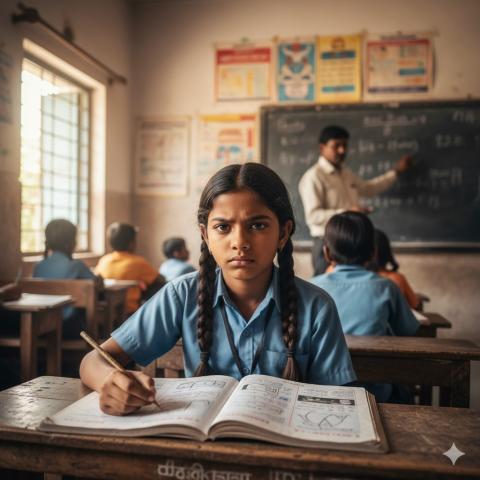
Simple for Me, Not for Her
I was helping a child with a math lesson. All my training in patience seems to fall flat when I engage with her and try to teach her. She takes some time to understand the concept—and I think we all do. But I carry this assumption that if I explain once, she should get it. In agitation, I sometimes utter words that can be quite damaging. Last time, I used the word “terrible” twice.
This time, when I kept insisting on writing clearly and following the steps, she became agitated. She started yelling, “Mujhe kuch nahi aata.” At her age, I remember knowing nothing of what she already knows today. The real problem lies in the school system she is part of. They impose a lot of tough concepts on children at such a young age, which often damages their self-confidence.
On another day, I discovered that while she was struggling to learn a concept, I failed to teach as a teacher. She may have some problems as a learner, but I too have problems as a teacher. The assumption that this is such a ‘simple’ sum comes from my 41-year-old mind, and I am imposing it on a 9-year-old child. This is ‘simple’ for me, but not for her—and I don’t remember how I was doing when I was 9 years old.
I think this is exactly the problem most teachers demonstrate in the classroom. The problem doesn’t lie with the learner. What a learner is required to do—she accepts that she doesn’t know, she is there to learn, she even bears the judgments teachers pass, she ticks all the boxes a learner needs to. On the contrary, as a teacher, I fail. While explaining a concept the 3rd or 4th time, my pen writes faster, my voice turns loud and trembles, and I start spitting value judgments… “Ye bhi nahi ho raha hai tumse! Arre, ye to sabko aata hai!”
The moment I realized it, I shared with her that it’s not that she is facing a problem learning this concept—I too am facing a problem teaching it. But I am not being judged, because the power dynamics favor me. I am a teacher, and a person with a PhD in education too. But my judgments deeply hurt her self and her ideas about herself. At times, she starts saying… “Main to ye kar hi nahi sakti.”
The statement should have been from my side—“Main to ye padha hi nahi sakta.” But my power position hides my inability not only from her, but also from myself, and I live with my assumption that, oh, this is such a ‘simple’ concept. I have no evidence to trace how this became ‘simple’ to me.
I am writing this in my context, but I am also aware that most students face this, and most teachers live under this fallacy—that they know the concept, and knowing itself is teaching the concept well. In one-to-one situations, this is still bearable, but in the classroom, when teachers pass judgments, this becomes more dangerous. The moment a teacher passes judgment, the rest of the students laugh and make faces. They also learn that they need to stay silent when they don’t understand—otherwise, what one child has faced, they will face next time. Gradually, the teacher achieves a status which, unfortunately, is celebrated in our schools—the status of a disciplined class. But most disciplined classes are basically silenced classes.
Being in this space for over one and a half decades now, I often feel and share with my students that children should be given a school passing certificate just because they survived school. That in itself is the greatest example of resilience. Otherwise, a lack of research-backed teaching culture—where we still derive the fundamentals of teaching from the tradition “Padne wale padh hi lete hain”—is causing much more harm to learners than we imagine.
Barring the few who, in Bruner’s words, have the corresponding language to excel and thrive in the school culture, the rest who don’t discover this corresponding language just somehow survive—and many do not. The dropout rate at the secondary level is 10.9%, as per the 2023–24 UDISE data. In absolute numbers, this runs into millions.
Where does the story begin? It was about my personal experience of teaching a child. But things become quite problematic when we see the larger picture—where class sizes are overcrowded, most teachers don’t have exposure to quality higher education, and other infrastructure-related issues. Teachers may find their limitations by reflecting on their pedagogy, but this is more of a systemic issue. Unless we strive to value the learning journey of each child, millions will continue to be sacrificed in our classrooms.
- Log in to post comments
